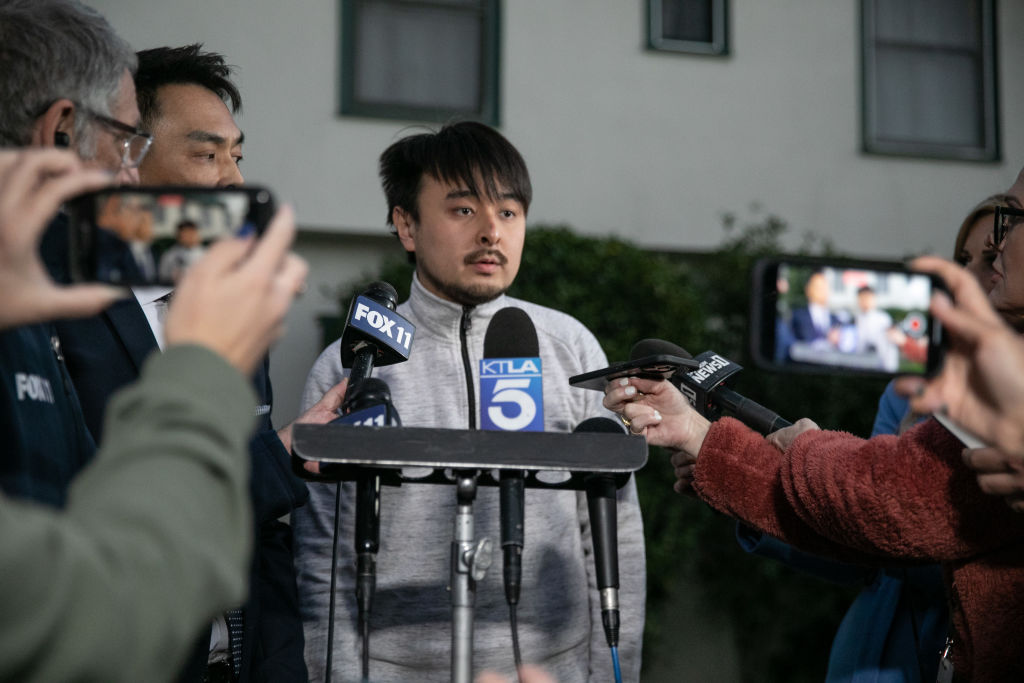Brandon Tsay is being praised for his bravery after the 26-year-old disarmed the Monterey Park shooter on Saturday night at the Lai Lai Ballroom & Studio.
“There was a moment I actually froze up because I had a belief that I was going to die,” Tsay told NBC News. “[The shooter] started to try to prep his weapon so he could shoot everybody, then it dawned on me this was the moment to disarm him. I could do something here that could protect everybody and potentially save myself.”
The gunman has since been identified as 72-year-old Huu Can Tran, who arrived at the dance studio after killing 11 people and wounding at least nine others at a different site. Tran fled the scene, then died of a self-inflicted gunshot wound after an hours-long standoff with police.
A series of three mass shootings within eight days in California has resurfaced the debate over the best way to respond to these occurrences, as critics of gun control have long argued that a “good guy with a gun” is the best way to stop a “bad guy with a gun.” But some experts note that while every case is situational, more guns—particularly when in the hands of untrained people—can often increase the risk of casualties.
“A gun is substantially more lethal than any other weapon—so when you introduce guns into situations, you essentially increase the likelihood that a person will die,” says Emma Fridel, an assistant professor of criminology and criminal justice at Florida State University. Even if well-intentioned, bystanders with guns could accidentally strike an innocent person or, if they engage in gunfire, confuse law enforcement about the perpetrator’s identity, Fridel explains.

Training can be key. “A good guy with a gun is very different than, say, a well-trained good guy with a gun who has practiced this sort of situation,” says David Hemenway, director of the Harvard Injury Control Research Center. But training, in this context, doesn’t just mean knowing how to shoot a gun—it also means experience in simulations where your adrenaline is high and your “heart’s beating like crazy,” Hemenway adds.
Hemenway co-authored a 2015 study that reviewed data from the National Crime Victimization Surveys from 2007-2011 and found that the use of a gun as self-defense is a rare event. “Results from the NCVS find that guns are used by victims in less than 1% of crimes in which there is personal contact between the perpetrator and victim, and about 1% in cases of robbery and (non-sexual) assault,” the study stated.
Read More: The ‘Good Guys With Guns’ Keep Failing to Stop Mass Shootings
Anecdotally, there are several recent accounts of unarmed people stopping shooters. In 2018, unarmed science teacher Jason Seaman helped stop a shooting at an Indiana middle school. That same year, James Shaw wrestled an assault rifle away from a gunman after he killed four people at a Tennessee Waffle House. And in 2022, an unarmed Richard Fierro tackled a gunman at Club Q, a nightclub in Colorado Springs, and beat him bloody with the weapon.
When Fierro learned of Tsay’s heroic efforts this week, he was struck by the parallels with his own experience disarming a gunman just months ago.
“The way he described it was literally the same way I was describing it: there was no thought process because you had to do what you did to protect people and yourself,” Fierro says in an interview with TIME. “It was eerily similar.”
Fierro is skeptical that having a gun would have been beneficial when he took on his assailant. “Having a gunfight is not going to help anybody,” he says. His wife later told him that if he had a gun and started shooting at the gunman, he could have mistakenly shot her, too.
Fierro and Tsay faced somewhat different circumstances in their respective shootings. Fierro is a trained veteran, who served for 15 years in the military. But he was in a room full of strangers, in the dark, with “thumping music, laser beams and all this other crap going on.” Meanwhile Tsay had never held a gun before, but there was no crowd and the assailant had directly pointed his weapon at him.
And Fridel points out that Tsay may have been at a marginal advantage because of the respective difference in age and strength between the two men. She cautions that it always depends on the situation and that “every person should make a decision based on what they think is going to be most effective at saving their life and other people’s lives.”
Despite the differences in their situations, Fierro notes that they will have one thing in common: “this is an event that changes everybody involved forever,” he says, adding that he has been dealing with PTSD.
“Five years from now, you’re going to get angry beyond what you should get angry about…somebody leaves a light switch on or you stepped on a lego… and that’s where it’s hard to move forward.”
More Must-Reads From TIME
- The 100 Most Influential People of 2024
- The Revolution of Yulia Navalnaya
- 6 Compliments That Land Every Time
- What's the Deal With the Bitcoin Halving?
- If You're Dating Right Now , You're Brave: Column
- The AI That Could Heal a Divided Internet
- Fallout Is a Brilliant Model for the Future of Video Game Adaptations
- Want Weekly Recs on What to Watch, Read, and More? Sign Up for Worth Your Time
Write to Sanya Mansoor at sanya.mansoor@time.com